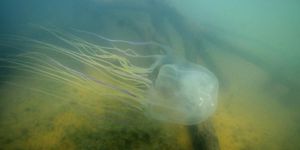How a Parasitic Amoeba Evades the Immune System
A parasitic amoeba called Entamoeba histolytica is known for causing a serious disorder, primarily in tropical areas. The amoeba camps out in the human gut, where it leads to diarrhea, bleeding, and ulcers. It can also exit the gut and attack other organs in the worst cases. Now University of California, Davis researchers have learned that the amoeba can shield itself from the immune system by nibbling on host cells and adding their proteins to its surface. The findings were reported in mBio.
"We're very excited about how this ties into amoebic infection and into broader themes in cell biology," said Katherine Ralston, assistant professor in the Department of Microbiology and Molecular Genetics, College of Biological Sciences.
In a process called phagocytosis, a cell can consume another one. Amoebae and a lot of other cell types can phagocytose other cells, but some can also grab bits of those cells, a process called trogocytosis, or what Ralston calls ‘cell nibbling.’ “The amoeba quite literally takes bites out of other cells," Ralston explained. "This nibbling is how it attacks individual cells, and we think this is how it causes ulceration and damage to the human intestine."
Trogocytosis is seen in parasitic amoebae, as well as multicellular organisms. Immune system cells are able to bite off and swap bits of their surface with one another other, for example.
"We thought that if amoebae can take proteins from host cells and put them on their own surface this would have a functional effect on how they survive in the body," said graduate student Hannah Miller.
In the video above, from a 2014 Nature publication, researchers show that human cell material gets internalized by Entamoeba histolytica.
The complement system is a group of proteins that work in the blood to fend off pathogens. One’s own cells have proteins that stop complement from attacking them. In this work, the researchers exposed the amoebae to human cells, and the amoebae could use the proteins that prevent the complement attack like a camouflage. Entamoebae that didn’t use those proteins got destroyed, while camouflaged amoebae survived.
Millers noted that the camouflage can protect the amoebae as they move through the bloodstream.
The researchers are continuing to investigate trogocytosis. They also want to know, for example, what happens to the proteins that the amoebae take, and how they are brought to the membrane.
"We're really excited that this decoration with acquired proteins might apply to trogocytosis in general because we're realizing that it's important in so many contexts," Ralston added.
The disease caused by the amoeba is outlined in the video.
Sources: AAAS/Eurekalert! via UC Davis, mBio









